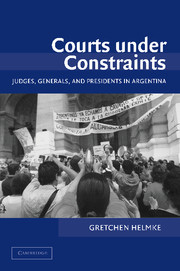Book contents
- Frontmatter
- Contents
- List of Tables
- List of Figures
- Preface and Acknowledgments
- 1 RULING AGAINST THE RULERS
- 2 THE LOGIC OF STRATEGIC DEFECTION
- 3 A THEORY OF COURT-EXECUTIVE RELATIONS: INSECURE TENURE, INCOMPLETE INFORMATION, AND STRATEGIC BEHAVIOR
- 4 JUDGES, GENERALS, AND PRESIDENTS: INSTITUTIONAL INSECURITY ON THE ARGENTINE SUPREME COURT, 1976–1999
- 5 THE REVERSE LEGAL-POLITICAL CYCLE: AN ANALYSIS OF DECISION MAKING ON THE ARGENTINE SUPREME COURT
- 6 THE DYNAMICS OF DEFECTION: HUMAN RIGHTS, CIVIL LIBERTIES, AND PRESIDENTIAL POWER
- 7 CONCLUSION: BROADER LESSONS AND FUTURE DIRECTIONS
- Appendix A Overview of the Federal Argentine Judiciary and the Argentine Supreme Court
- Appendix B The Argentine Supreme Court Decisions Data Set
- Appendix C Equilibria Proofs
- References
- Index
Appendix B - The Argentine Supreme Court Decisions Data Set
Published online by Cambridge University Press: 24 July 2009
- Frontmatter
- Contents
- List of Tables
- List of Figures
- Preface and Acknowledgments
- 1 RULING AGAINST THE RULERS
- 2 THE LOGIC OF STRATEGIC DEFECTION
- 3 A THEORY OF COURT-EXECUTIVE RELATIONS: INSECURE TENURE, INCOMPLETE INFORMATION, AND STRATEGIC BEHAVIOR
- 4 JUDGES, GENERALS, AND PRESIDENTS: INSTITUTIONAL INSECURITY ON THE ARGENTINE SUPREME COURT, 1976–1999
- 5 THE REVERSE LEGAL-POLITICAL CYCLE: AN ANALYSIS OF DECISION MAKING ON THE ARGENTINE SUPREME COURT
- 6 THE DYNAMICS OF DEFECTION: HUMAN RIGHTS, CIVIL LIBERTIES, AND PRESIDENTIAL POWER
- 7 CONCLUSION: BROADER LESSONS AND FUTURE DIRECTIONS
- Appendix A Overview of the Federal Argentine Judiciary and the Argentine Supreme Court
- Appendix B The Argentine Supreme Court Decisions Data Set
- Appendix C Equilibria Proofs
- References
- Index
Summary
One of the main tasks of field research was to develop and to implement a method for systematically measuring judicial behavior. Ideally, the goal was to construct a data base that would include all cases in which the government had some identifiable interest. The most appropriate method for selecting such cases, however, was not immediately obvious. In contrast to the U.S. Supreme Court, the Argentine Court hands down thousands of decisions every year, many of which have nothing to do with the interests of the government. Thus, coding neither all decisions nor a random sample was appropriate.
Other more refined techniques also proved either unsatisfactory or simply were too difficult to implement given the context. For example, I initially sought to replicate Robert Dahl's method (1957) by examining the Argentine Court's use of judicial review in constitutional cases. Although I was able to gain access to the Argentine Supreme Court's computer system to locate “constitutional cases,” it became clear that there was no necessary overlap between these cases and cases in which one could identify the interest of the government. As a result, many of the cases that made the constitutional list did not serve as a very good measure of judicial subservience to the government per se.
A different method, which might have overcome this problem, would have been to use amicus curiae (friends of the court) briefs filed by the government to identify the government's interests.
- Type
- Chapter
- Information
- Courts under ConstraintsJudges, Generals, and Presidents in Argentina, pp. 182 - 188Publisher: Cambridge University PressPrint publication year: 2004



